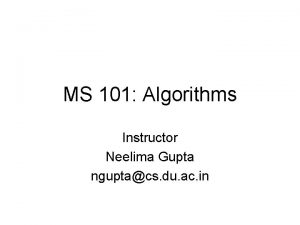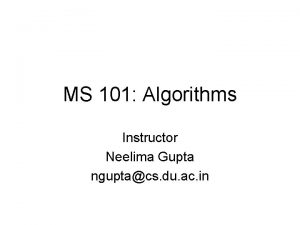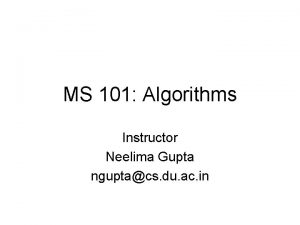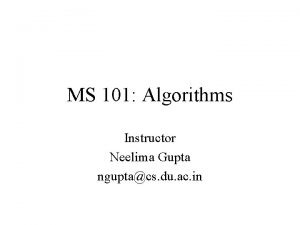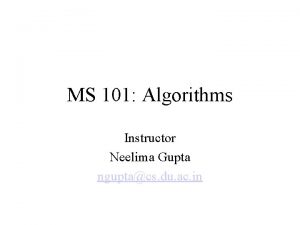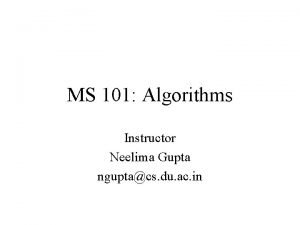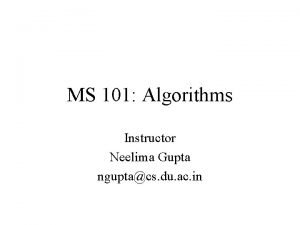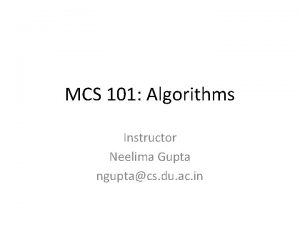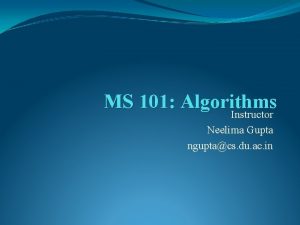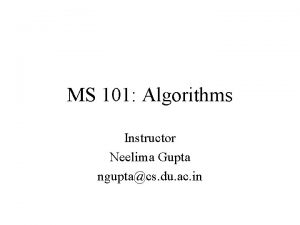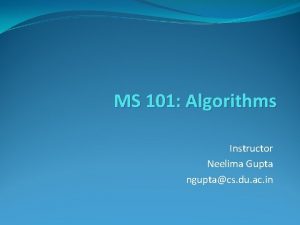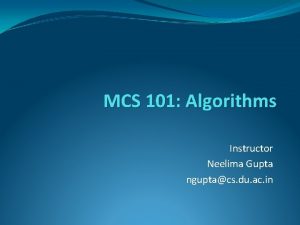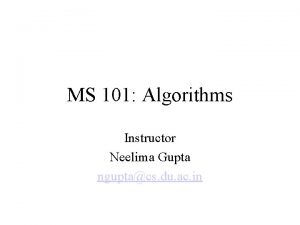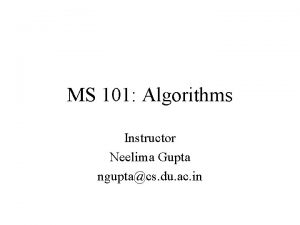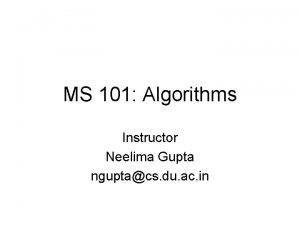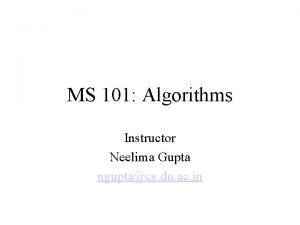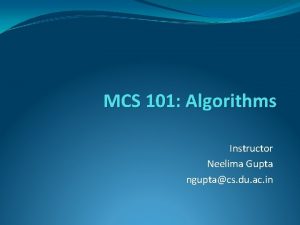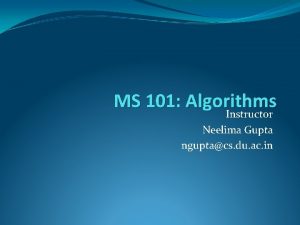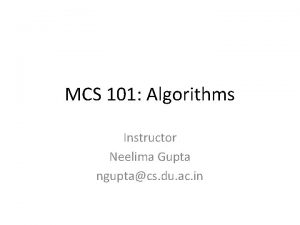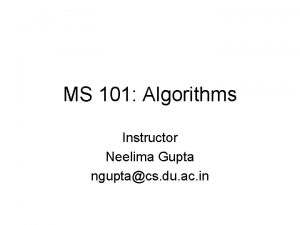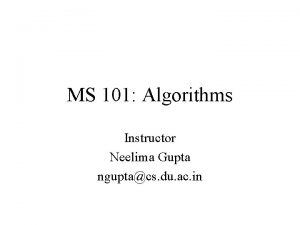MS 101 Algorithms Instructor Neelima Gupta nguptacs du

































- Slides: 33

MS 101: Algorithms Instructor Neelima Gupta ngupta@cs. du. ac. in

Table of Contents Greedy Algorithms

What is greedy approach? �Choosing a current best solution without worrying about future. In other words the choice does not depend upon future sub-problems. �Such algorithms are locally optimal, �For some problems, as we will see shortly, this local optimal is global optimal also and we are happy.

General ‘Greedy’ Approach �Step 1: �Choose the current best solution. �Step 2: �Obtain greedy solution on the rest.

When to use? �There must be a greedy choice to make. �The problem must have an optimal substructure.

Activity Selection Problem �Given a set of activities, S = {a 1, a 2, …, an} that need to use some resource. �Each activity ai has a possible start time si & finish time fi, such that 0 si < fi < �We need to allocate the resource in a compatible manner, such that the number of activities getting the resource is maximized. �The resource can be used by one and only one activity at any given time. .

Activity Selection Problem �Two activities ai and aj are said to be compatible, if the interval they span do not overlap. . . i. e. fi sj or fj si �Example: �Consider activities: a 1, a 2, a 3, a 4 s 1 ----f 1 s 2 -----f 2 s 3 ------f 3 s 4 ------f 4 �Here a 1 is compatible with a 3 & a 4 �a 2 is compatible with a 3 & a 4 �But a 3 and a 4 themselves are not compatible.

Activity Selection Problem �Solution: Applying the general greedy algorithm �Select the current best choice, a 1 add it to the solution set. �Construct a subset S’ of all activities compatible with a 1, find the optimal solution of this subset. �Join the two.

Lets think of some possible greedy solutions �Shortest Job First �In the order of increasing start times �In the order of increasing finish times

Shortest Job First job 1 job 2 job 3 0 1 2 3 4 5 6 7 8 9 Time Thanks to: Navneet Kaur(22), MCA 2012 10 11 12 13 14 15

Shortest Job First job 1 job 2 job 3 0 1 2 3 4 5 6 7 8 9 Time Thanks to: Navneet Kaur(22), MCA 2012 10 11 12 13 14 15

Shortest Job First job 1 job 2 job 3 0 1 2 3 4 5 6 7 SCHEDULE CHOSEN BY THIS APPROACH OPTIMAL SCHEDULE 8 9 Thanks to: Navneet Kaur(22), MCA 2012 10 11 12 13 14 Time 15

Increasing Start Times job 1 job 2 job 3 0 2 4 6 8 10 12 14 16 Thanks to: Navneet Kaur(22), MCA 2012 18 20 Time

Increasing Start Times job 1 job 2 job 3 0 2 4 6 8 10 12 14 16 Thanks to: Navneet Kaur(22), MCA 2012 18 20 Time

Increasing Start Times job 1 job 2 job 3 0 2 14 4 6 8 10 12 SCHEDULE CHOSEN BY THIS APPROACH OPTIMAL SCHEDULE 16 Thanks to: Navneet Kaur(22), MCA 2012 18 20 Time

Increasing Finishing Times i � 2 � 1 � 3 � 4 � 5 Si Fi 2 1 4 5 6 Thanks to Neha (16) Pi 4 5 6 8 9 3 10 4 20 2

Increasing Finishing Times P(1)=10 P(2)=3 P(3)=4 P(4)=20 P(5)=2 0 1 2 3 4 5 6 7 Thanks to Neha (16) 8 9 Time

Increasing Finishing Times P(1)=10 P(2)=3 P(3)=4 P(4)=20 P(5)=2 0 1 2 3 4 5 6 7 . Thanks to Neha (16) 8 9 Time

ACTIVITY SELECTION PROBLEM We include a₁ in the solution. And then recurse on S′ = {aₓ ԑ S-{a₁} : aₓ is compatible with a₁} where S is input set of activities. Thanks to: Navneet Kaur(22), MCA 2012

Proving the Optimality

Scheduling Jobs with Processing times and Deadlines �Jobs are given with processing times pi and deadlines d i. �There is no specified start time. A job can be scheduled at any time. Algorithm decides the start time ( and hence the finish time) of a job. �Let fi be the time at which a job finishes as per some schedule. Then its lateness is defined as li = fi – di if fi>di 0 , otherwise �Aim : minimize max lateness i. e. minimize max{li}

Figures from Anjali, Hemant

Possible Greedy Approaches �Shortest Job First: completely ignores half of the input data viz. the deadlines �Doesn’t work : � t 1 = 1, d 1=100, t 2=10, d 2=10 �Minimum Slackness First �Doesn’t work : � t 1 = 1, d 1=2, t 2=10, d 2=10 �Earliest Deadline First: completely ignores the other half of the input data viz. the processing time…. but it works…. gives the optimal

SJF fails: figure from Anjali, Hemant back

q. Minimum Slackness First � Let si be the time by which the job must be assigned to meet the deadline. i. e. si = di – pi �Let the last job scheduled finishes at time t. Then slacktime for job i is defined as sti = si – t. �Thus slack time represents, how much we can wait/defer to schedule the ith job. �We should schedule the next job for which this time is minimum. i. e. sti is minimum. Since t is same for all the jobs, the job with minimum si is scheduled next.

MSF fails: figure from Anjali, Hemant back

Earliest Deadline First d 1<=d 2<=d 3…. . <=dn s 2=f 1 j 2 f 1=p 1 s 3=f 2 j 3 f 2=f 1+p 2

Exchange Argument • Let O be an optimal solution and S be the solution obtained by our greedy. • Gradually we transform O into S without hurting its (O’s) quality. Thereby implying that |O| = |S|. • Hence proving that greedy is optimal.

q. Inversion We say that a schedule A has an inversion if a job i with deadline di is scheduled before another job j with earlier deadline( dj<di). q Idle Time -The time that passes during a gap -There is work to be done, yet for some reason the machine is sitting idle.

Earliest Deadline First �Claim: Our schedule has no inversions and no idle time…. trivial �Clearly Optimal has no idle time. � 1. All schedules with no inversion and no idle time has same maximum lateness �Proof: � 2. There is an optimal schedule with no inversion and no idle time. �A. If O (an optimal) has an inversion there is a pair of jobs I an j such that j is scheduled immediately after I and d_j < d_i…. i. e. pair of inverted jobs that are consecutive. �Proof: �B. The new swapped schedule has maximum lateness no larger than that of O. �Proof:

Proof of 1. : Anjali, Hemant

Network Design Problems �Given a set of routers placed at n locations V = {v 1 … vn} �We want to connect them in a cheapest way. �Claim: The minimum cost solution to the above problem is a tree.

Minimum Spanning Tree �Assume that all edges have distinct edge costs. We’ll remove this restriction later. �Greedy Approaches: �Kruskal �Prim’s �Reverse Delete �Cut Property: Let S be a non-trivial subset of V, let e = (v, w) be the minimum weight edge with one end in S and the other end in V – S. Then every MST contains e.
 Neelima gupta delhi university
Neelima gupta delhi university Brahmi
Brahmi Clinux
Clinux Nfpa 1403
Nfpa 1403 Virtual instructor art
Virtual instructor art Delmar cengage learning instructor resources
Delmar cengage learning instructor resources Nra certified instructor logo
Nra certified instructor logo Pepperball training manual
Pepperball training manual Instructor
Instructor Mptc firearms
Mptc firearms Medical terminology instructor
Medical terminology instructor Nrp instructor toolkit
Nrp instructor toolkit Basic instructor course tcole
Basic instructor course tcole Tp 12863
Tp 12863 Instructor office hours
Instructor office hours Naismith was an instructor of
Naismith was an instructor of Everyone selected to serve on this jury
Everyone selected to serve on this jury Tcole advanced instructor course
Tcole advanced instructor course Instructor responsibilities and professionalism
Instructor responsibilities and professionalism Tcole advanced instructor course
Tcole advanced instructor course Basic instructor course #1014
Basic instructor course #1014 Utp cable
Utp cable Basic instructor course texas
Basic instructor course texas Instructor operating station
Instructor operating station Jrotc marksmanship instructor course online
Jrotc marksmanship instructor course online Please clean your room
Please clean your room Instructor vs teacher
Instructor vs teacher Tcole 1014 basic instructor course
Tcole 1014 basic instructor course Basic instructor course texas
Basic instructor course texas Basic instructor course tcole
Basic instructor course tcole Cbrf registry wi
Cbrf registry wi Basic instructor course #1014
Basic instructor course #1014 Catia instructor
Catia instructor Cisco certified instructor
Cisco certified instructor
